Key takeaways:
- Inclusive policies foster a sense of belonging and should reflect the diverse voices of employees to address their unique needs.
- Clear communication and ongoing training are essential for implementing effective inclusive policies that are lived and practiced within the workplace.
- Engaging employees through feedback and focus groups enhances policy effectiveness and builds trust in the organization.
- Policy development is an ongoing journey that requires adaptability, reflection, and commitment to continuous improvement.
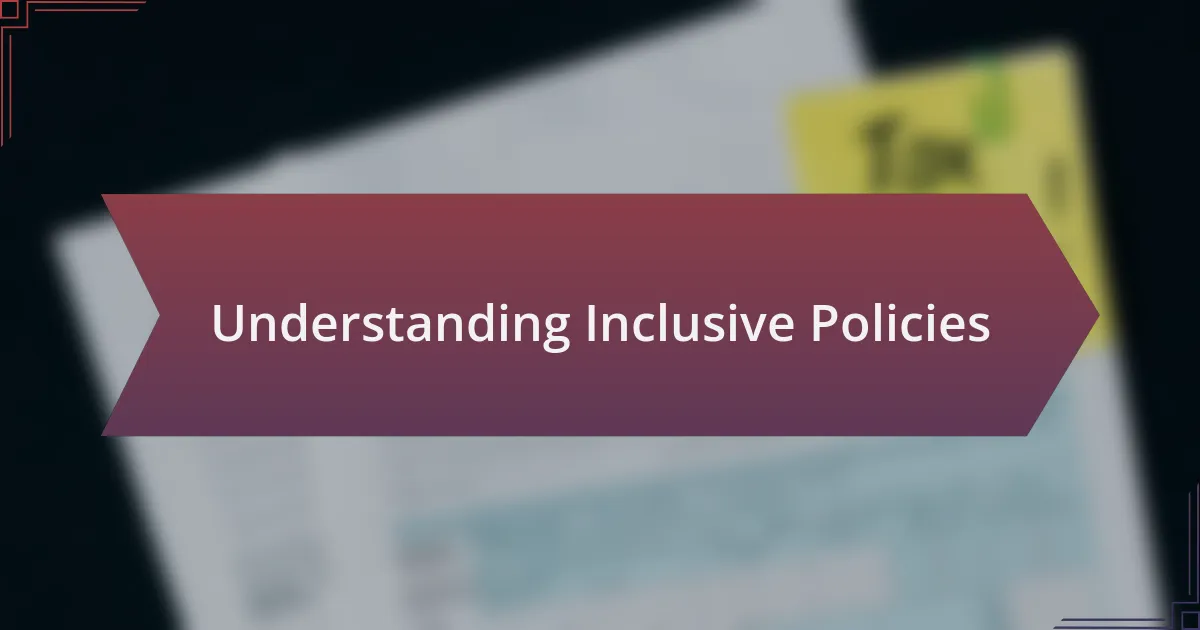
Understanding Inclusive Policies
When I first began exploring inclusive policies, I was struck by their importance in fostering a sense of belonging within the workplace. It made me realize that these policies are not just compliance checkboxes; they are fundamental in creating an environment where everyone feels valued and respected. Have you ever walked into a space that just felt welcoming? That’s the magic of inclusive policies at work.
One memorable experience I had was during a team meeting where we discussed our policy revisions. Listening to my colleagues share their perspectives opened my eyes to the diverse needs and challenges they face. It was a powerful reminder that inclusive policies should reflect the voices of those they intend to support. What if we could create an environment where every individual’s input shapes our workplace culture?
Understanding inclusive policies also means recognizing the ongoing nature of this commitment. I often think about how these policies should evolve as our workforce changes. For instance, regularly soliciting feedback isn’t just a formality; it’s essential for genuinely addressing the needs of a diverse team. How can we expect to meet varying needs without consistent dialogue?
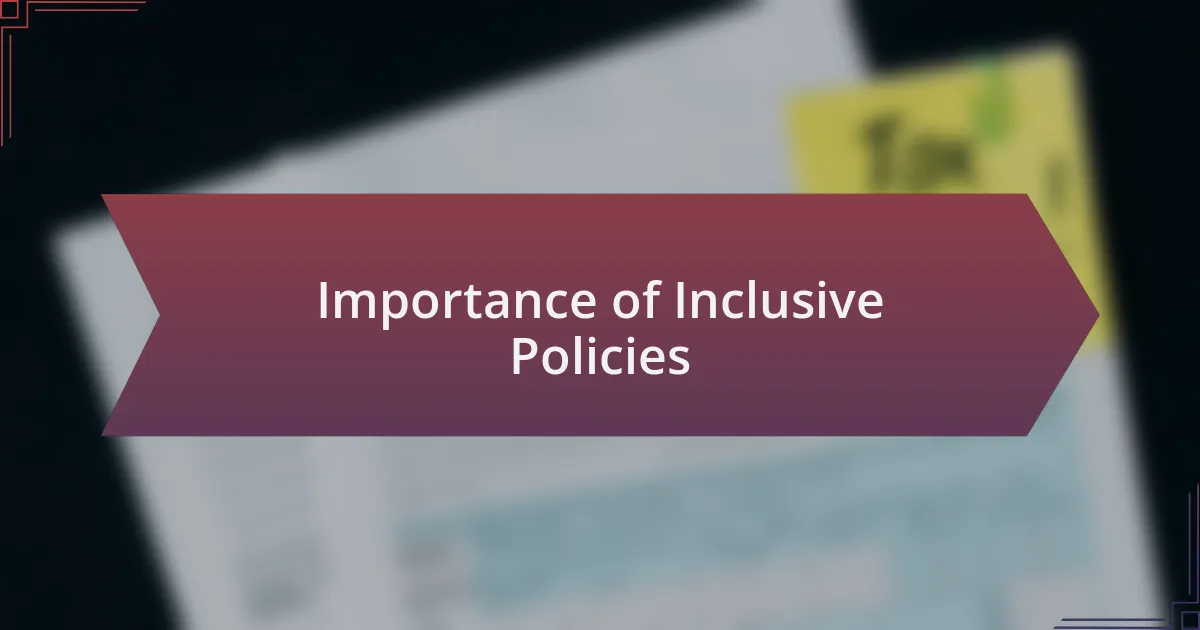
Importance of Inclusive Policies
Fostering an inclusive workplace is not just beneficial for employees; it can significantly impact a company’s performance. In my experience, when a workplace prioritizes inclusivity, productivity often blossoms. Team members who feel acknowledged are more motivated. Have you noticed how engaged a team member becomes when their unique contribution is recognized? It’s infectious.
Inclusive policies also attract a broader talent pool, allowing organizations to benefit from diverse perspectives. I remember a hiring round where we prioritized candidates from various backgrounds. The innovation that stemmed from those different viewpoints was remarkable. It made me wonder: how much creativity might we miss out on when we only look for candidates who fit a single mold?
Moreover, inclusive policies can mitigate legal risks, enhancing compliance with employment laws. I’ve experienced situations where misunderstandings arose simply from a lack of clarity in policies. By actively working to make policies inclusive and clear, companies not only provide a safer environment for employees but also protect themselves from potential litigation. Isn’t it worth it to take proactive steps to avoid issues down the road?
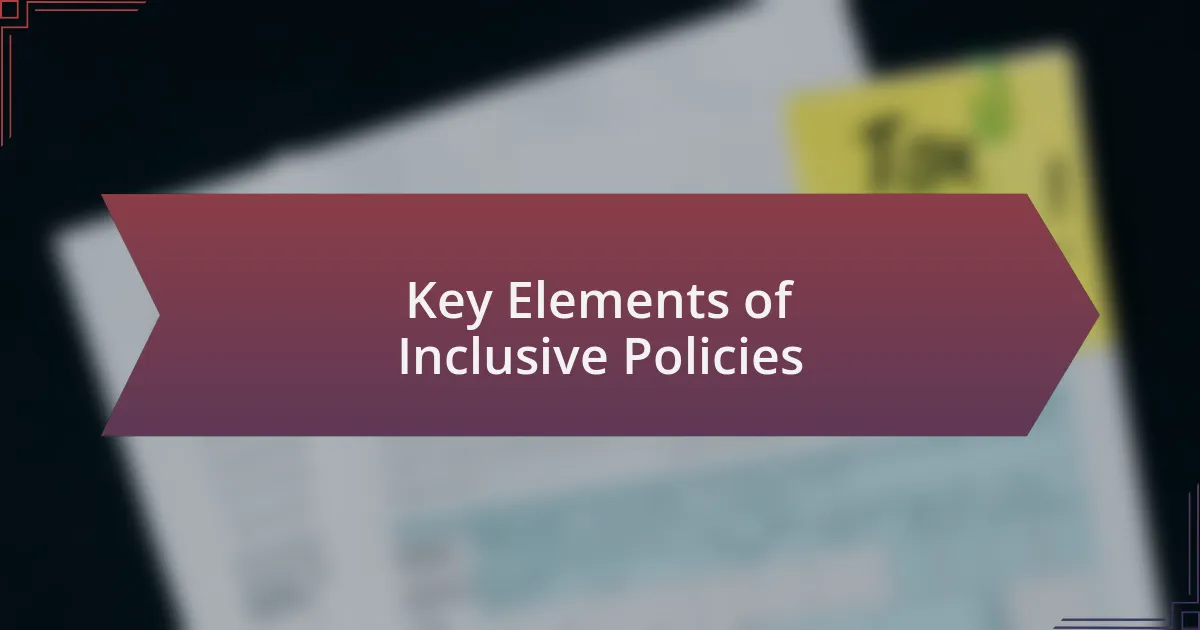
Key Elements of Inclusive Policies
A fundamental aspect of inclusive policies is clear communication. I remember drafting a new workplace guideline aimed at accommodating employees with disabilities. It was essential to articulate how these policies would work in practice—clarifying processes, available resources, and support mechanisms. When everyone understands what’s expected, the environment becomes more welcoming. Who wouldn’t want to thrive in a space where they know they belong?
Furthermore, it’s crucial that these policies genuinely reflect the needs of the workforce. In my previous role, we conducted surveys to gather feedback on what employees truly desired in terms of inclusivity. The insights we gained were eye-opening. I realized that asking for input not only helped shape policies but also demonstrated to employees that their voices matter. Have you ever felt more valued when your opinion is sought?
Lastly, the enforcement of inclusive policies is just as important as their creation. I recall a time when a team member raised a concern about unequal treatment. Addressing it swiftly—actively reinforcing our commitment to fairness—strengthened trust within the team. It highlighted that our policies weren’t just words on paper; they were living principles guiding our actions. Isn’t it vital for employees to see tangible examples of how these policies make a difference?
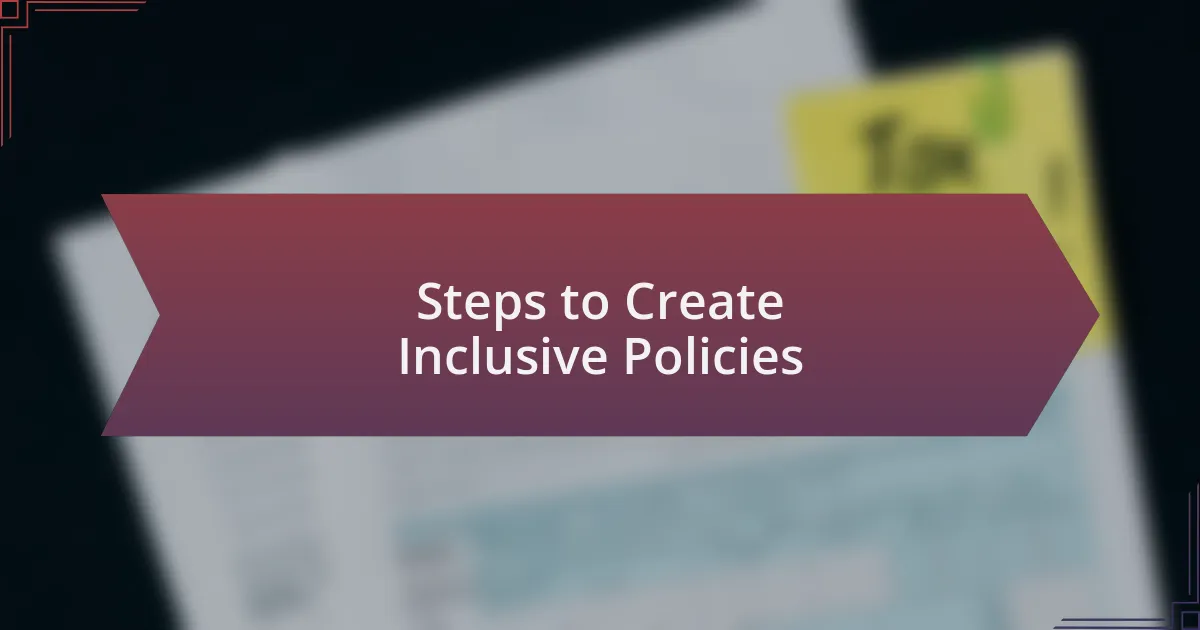
Steps to Create Inclusive Policies
Creating inclusive policies begins with thorough research to understand the unique needs of your workforce. I recall participating in focus groups where we discussed potential barriers for underrepresented groups. It was enlightening to hear firsthand experiences and find unexpected challenges. Have you ever considered that what seems obvious to you might not be the same for others?
Once you have gathered this vital information, the next step is to draft policies that are flexible and adaptable. In one instance, I put together a policy on remote work that allowed for customizable hours, recognizing that flexibility could be key for employees with caregiving responsibilities. This not only improved morale but also increased productivity. Isn’t it amazing how a simple adjustment can make a profound difference in someone’s life?
Finally, I’ve learned the importance of ongoing training and support to ensure everyone understands and upholds these policies. I remember leading a workshop where we tackled unconscious biases in hiring. Watching participants engage and challenge their perspectives was inspiring. How often do we take the time to reflect on our assumptions? Regular training fosters an inclusive culture where policies aren’t just implemented but lived and breathed.
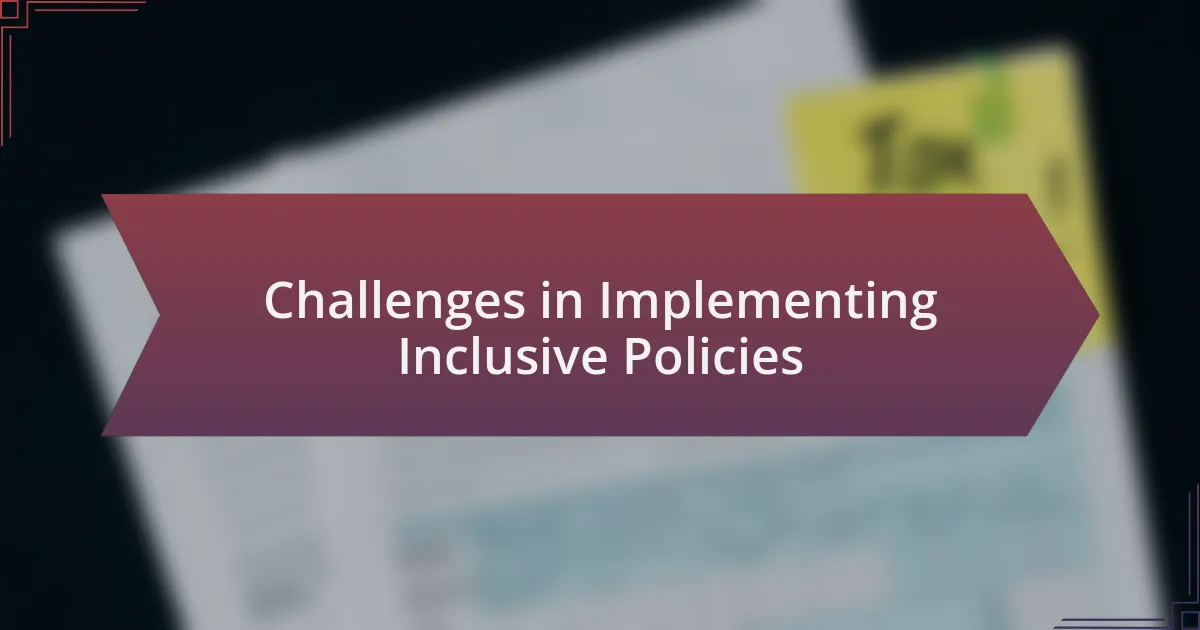
Challenges in Implementing Inclusive Policies
Implementing inclusive policies isn’t without its obstacles. I vividly remember a time when I rolled out a new policy aimed at enhancing diversity in interview panels. Some team members resisted, fearing it would complicate their usual processes. It made me ponder: how can we encourage acceptance of change when it threatens our comfortable routines?
Another challenge I faced was measuring the impact of these policies effectively. In one instance, we introduced mentorship programs designed to support underrepresented employees. It was disheartening to see participation rates lagging initially. This led me to reflect on why people might hesitate to engage. Are we communicating the benefits clearly enough, or are we unintentionally creating barriers?
Additionally, resistance can stem from a lack of understanding about the importance of inclusivity. I once had a candid conversation with a colleague who dismissed the idea of tailored training sessions. Listening to their concerns made me realize that educating everyone on the broader benefits of inclusivity in the workplace is crucial. What if we took the time to share stories that demonstrate how inclusion fosters a healthier, more productive work environment?
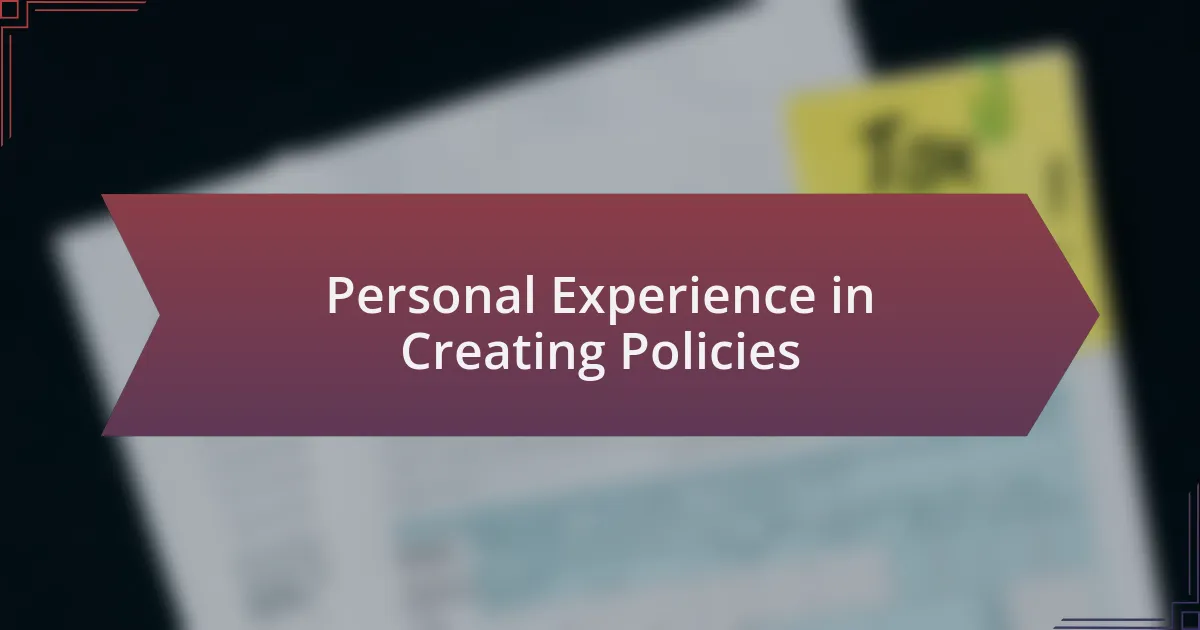
Personal Experience in Creating Policies
When I set out to create an inclusive policy for our workplace, I found it essential to involve diverse voices in the drafting process. I organized focus groups, and it was eye-opening to hear firsthand accounts from employees about their experiences. Did I realize then how different perspectives could enrich our policies? Absolutely—it reinforced my belief that true inclusivity starts with active listening.
During the policy rollout, I was caught off guard by the emotional reactions I encountered. One employee shared how policies that seemed abstract to some were deeply personal for others. Hearing her story made me question: How can we bridge the gap between policy and personal experience? It became clear that our policies must be rooted in empathy and understanding to resonate with everyone.
As I navigated feedback sessions post-implementation, it was a mix of pride and anxiety. I felt a tangible shift in the atmosphere, but I also worried whether we were meeting expectations. A colleague once thanked me for fostering a supportive environment, but I couldn’t shake my concern: Were we truly making a difference? Continual reflection on our journey reminded me that creating such policies is not a one-time event—it’s a commitment to ongoing learning and improvement.

Lessons Learned from Policy Creation
When developing the inclusive policy, I quickly learned the importance of adaptability. Initially, I thought our draft was ready to go, but feedback from the focus groups revealed gaps I hadn’t anticipated. This taught me that flexibility is crucial; sometimes, the best ideas come from unexpected discussions.
During the policy rollout, a poignant moment occurred when an employee shared how inclusive practices gave her the courage to speak up for the first time in meetings. It struck me deeply and made me reflect: How often do we overlook the power of a single voice in a sea of silence? That experience reinforced my understanding that policies must empower individuals, not just serve as guidelines.
In the months following implementation, I faced continuous challenges as new situations arose that the policy didn’t cover. Each challenge brought with it a mix of frustration and opportunity. It prompted me to ask myself, how can I ensure our policies evolve along with our workforce? This realization emphasized that policy creation is not just a starting point; it’s an evolving journey that requires constant engagement and refinement.